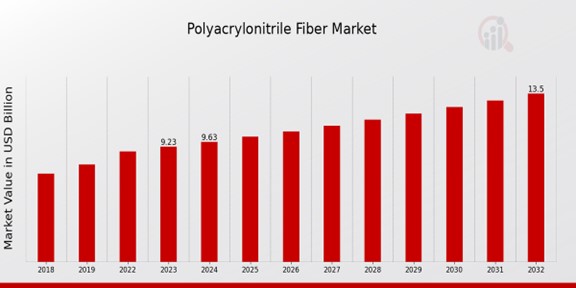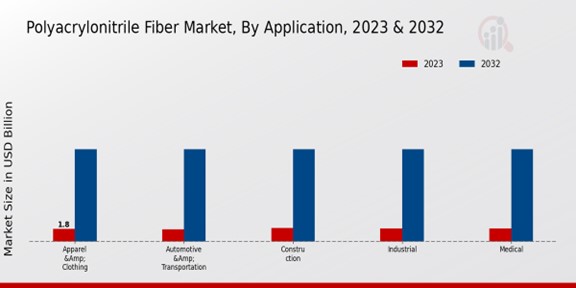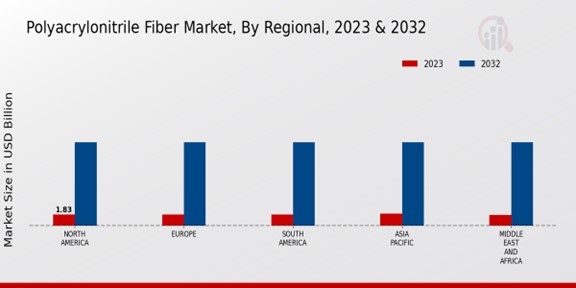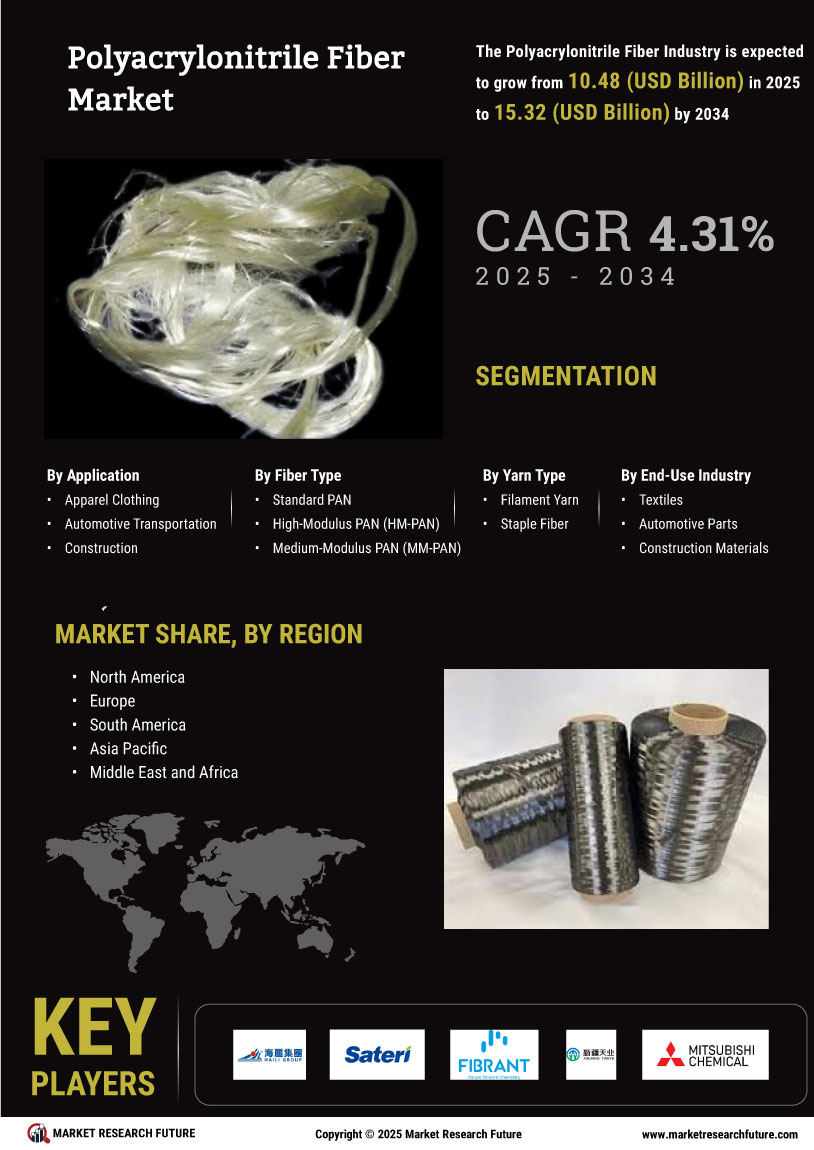Global Polyacrylonitrile Fiber Market Overview
The Polyacrylonitrile Fiber Market Size was estimated at 10.04 (USD Billion) in 2024. The Polyacrylonitrile Fiber Industry is expected to grow from 10.48 (USD Billion) in 2025 to 15.32 (USD Billion) by 2034. The Polyacrylonitrile Fiber Market CAGR (growth rate) is expected to be around 4.31% during the forecast period (2025 - 2034).
Key Polyacrylonitrile Fiber Market Trends Highlighted
Key market drivers for polyacrylonitrile fiber include the growing demand for lightweight, durable materials in automotive and aerospace applications, as well as the increasing use of carbon fiber in wind turbine blades. The rising consumer awareness about the environmental impact of synthetic fibers is also driving the demand for PAN fibers, which are biodegradable and recyclable.
Opportunities to be explored in the polyacrylonitrile fiber market include the development of new fiber blends with enhanced properties, such as flame retardancy and UV resistance. The growing adoption of carbon fiber-reinforced composites in various industries presents significant growth opportunities for PAN fiber manufacturers. Additionally, the expansion of the automotive and aerospace industries in emerging markets, particularly in Asia-Pacific, is expected to drive the demand for lightweight materials.
Recent trends in the polyacrylonitrile fiber market include the increasing use of PAN fibers in the production of carbon fiber, which is used as a reinforcement material in advanced composites. The development of new PAN fiber technologies, such as high-modulus and high-tenacity fibers, is also driving innovation in the market. Moreover, the growing focus on sustainable and environmentally friendly materials is leading to the adoption of PAN fibers in applications such as filtration and protective clothing.

Source: Primary Research, Secondary Research, MRFR Database and Analyst Review
Polyacrylonitrile Fiber Market Drivers
-
Growth in Automotive Industry
The automotive industry is a key driver of growth for the Polyacrylonitrile Fiber Market Industry. Polyacrylonitrile fibers have many applications in the automotive industry, such as tire reinforcement, seat covers, and interior trim. The increasing demand for lightweight and fuel-efficient vehicles is the driving factor for propelling the demand for polyacrylonitrile fibers. Moreover, the rise of electric vehicles is another factor expected to contribute to the growth of the automotive industry.
Furthermore, there is also demand for the fibers since they are suitable for electric vehicle batteries. The increase in demand and consumption of vehicles ly, growing middle class populations and the shifting of many vehicle manufacturers into developing countries are responsible for the expansion of the automotive industry which is the main driving factor of the growth of the Polyacrylonitrile Fiber Market Industry. The Polyacrylonitrile Fiber Market Industry is expected to grow at a CAGR of 4.31% from 2023 to 2032 reaching a total market size of USD 13.5 billion by 2032.
Increasing Demand for Carbon Fiber
Increasing demand for Carbon fiber: on-demand for carbon fiber is another dominant factor, which is contributing towards the Polyacrylonitrile Fiber Market Industry. Carbon fiber is a lightweight and robust fiber. It is being used worldwide for various applications in racing cars to aerospace, in sports goods to telephonic towers. The Polyacrylonitrile fibers are also used as its precursor in the manufacturing of carbon fiber. Hence, the growing demand for carbon fiber would drive the demand of Polyacrylonitrile fibers.
The Polyacrylonitrile Fiber Industry is anticipated to grow at a CAGR of 4.31% from 2023 to 2032. The total market size is projected to reach $13.5 billion by 2032. The major driving factors of the Polyacrylonitrile Fiber Industry is the expanding need of carbon fiber.
Growing Demand from Developing Economies
Another major driver of growth for the Polyacrylonitrile Fiber Market is the growing demand from developing economies. Polyacrylonitrile fibers have several applications such as textiles, automotive, and construction among others. The increasing demand for these applications in developing economies is subsequently driving the demands for polyacrylonitrile fibers. The Polyacrylonitrile Fiber Market Industry is poised to grow at a CAGR rate of 4.31% from 2023 to 2032 to reach a total market size of USD 13.5 billion by 2032.
Polyacrylonitrile Fiber Market Segment Insights
Polyacrylonitrile Fiber Market Application Insights
Five major application segments of Polyacrylonitrile Fiber Market are Apparel Clothing, Automotive Transportation, Construction, Industrial, and Medical. Apparel Clothing is a major application segment, which accounts for more than 50% in 2023. Polyacrylonitrile fibers are mainly used in wearing and clothing. They are used making sports, active, swim, and casual wears. The major drivers for growth are resistance to wrinkles and shrinking, well moisture absorption, and durability. Automotive Transportation is another significant application segment, which accounts for over 20% in 2023.
They are used in seat covers, carpets, headliners, and filters. The major drivers for growth include lighter weight than those of glass fibers, flame controllability and sound absorption. Construction, which accounts for over 15% in 2023, is the third-largest application. Polyacrylonitrile fibers are used in fireproof roofing materials and flooring materials in addition to insulation for transportation and equipment. The major reasons for growth are strength and durability, and resistance to chemicals and ultraviolet rays. Industrial is the fourth-largest, estimating over 10% in 2023.
They are utilized for filters, papers and composites. The major factors are high strength, mealy corrosion, and high heat resistance. The fifth-largest Medical is nearly 5% in 2023. These fiber is used for gowns, drapes, and wound dressings. The major factors are biocompatibility, sterility and resistance to bacteria and viruses. Increased demand in Apparel Clothing, Automotive Transportation, and Construction segments has been a catalyst for market expansion. But, growing credit should be on Medical and Industrial parts.

Source: Primary Research, Secondary Research, MRFR Database and Analyst Review
Polyacrylonitrile Fiber Market Fiber Type Insights
The Polyacrylonitrile Fiber Market segmentation by fiber type comprises standard PAN, high-modulus PAN (HM-PAN), medium-modulus PAN (MM-PAN), and carbon fiber precursor PAN. In 2023, the standard PAN segment held the largest revenue share of over 60.0%, owing to its wide applications in various industries such as automotive, aerospace, and construction. The high-modulus PAN segment is projected to exhibit the highest CAGR of 5.0% during the forecast period, driven by its superior strength and stiffness properties, which make it suitable for advanced applications such as composite materials and sporting goods.
The medium-modulus PAN segment is expected to account for a significant market share, owing to its balance of properties and cost-effectiveness. The carbon fiber precursor PAN segment is anticipated to witness steady growth, driven by the increasing demand for carbon fiber composites in various industries.
Polyacrylonitrile Fiber Market Yarn Type Insights
The Polyacrylonitrile Fiber Market is segmented by Yarn Type into Filament Yarn and Staple Fiber. The Filament Yarn segment accounted for a larger share of the Polyacrylonitrile Fiber Market in 2023. The Staple Fiber segment is projected to grow at a CAGR of 4.31% during the forecast period, reaching a valuation of USD 7.21 billion by 2032. The growth of the Filament Yarn segment is attributed to the increasing demand for high-performance fibers in various end-use industries, such as automotive, aerospace, and construction. Filament yarns are known for their high strength, modulus, and thermal stability, making them ideal for applications where durability and performance are critical.
The growth of the Staple Fiber segment is attributed to the increasing demand for synthetic fibers in the textile industry. Staple fibers are used in the production of a wide range of textiles, such as clothing, home furnishings, and industrial fabrics. Staple fibers are known for their softness, wrinkle resistance, and low moisture absorption, making them ideal for use in a variety of applications.
Polyacrylonitrile Fiber Market End-Use Industry Insights
The end-use industry segment plays a crucial role in shaping the Polyacrylonitrile Fiber Market. Among the key end-use industries, textiles dominate the market, accounting for a significant share of the Polyacrylonitrile Fiber Market revenue. The automotive parts industry is another major end-use sector, driven by the increasing demand for lightweight and durable materials in vehicle manufacturing. Construction materials, industrial composites, and medical devices also contribute to the market growth, each with unique applications and requirements.
The versatility of polyacrylonitrile fibers in these end-use industries highlights their importance in various sectors and their potential for continued market expansion in the coming years.
Polyacrylonitrile Fiber Market Regional Insights
The Polyacrylonitrile Fiber Market is segmented into North America, Europe, APAC, South America, and MEA. Among these regions, APAC is expected to hold the largest market share in the coming years. The rising demand for polyacrylonitrile fibers in the automotive and aerospace industries is driving the growth of the market in this region. North America and Europe are also expected to witness significant growth in the market due to the increasing demand for lightweight and durable materials in various applications. South America and MEA are expected to have a moderate growth rate in the market due to the growing construction and infrastructure industries in these regions.

Source: Primary Research, Secondary Research, MRFR Database and Analyst Review
Polyacrylonitrile Fiber Market Key Players And Competitive Insights
Major players in the Polyacrylonitrile Fiber Market industry are focusing on various growth strategies such as investing heavily in research and development to produce innovative and high-quality products. They are also adopting partnerships and collaboration strategies with other companies from other countries to enhance their reach and increase their product supply. Moreover, in the world market, Polyacrylonitrile Fiber Market development is getting increasingly more by the high demand of products by end-use industry from automotive, construction, and textile sector. Urbanization is increasing every day, and so it’s the disposal income of consumers in developing countries. To add to that, competition between the key players will stick to the use of high technology to produce the best quality products at the best qualities.
One the major competitors in the market is Toray Industries. It is a world leader in the production of carbon fibers as well as other highly advanced materials. It is favored in the automotive industry and aerospace, and it is highly likely to perform well due to the world’s high demand for lightweight products and strongly built. Another competitor in the market is Mitsubishi Rayon. The firm is a worldwide manufacturer of synthetic fibers and chemicals. Also, it has a strong market in the textile industry and is growing rapidly in the automotive and construction industry. In addition to that, Zhejiang Hengan Group is among the key players in the market space. It is currently the largest producer of disposable hygiene products and is in demand in China, and it is expanding its market into the nonwoven fabric space, and with disposable diapers.
Key Companies in the Polyacrylonitrile Fiber Market Include
Polyacrylonitrile Fiber Market Industry Developments
China Petroleum & Chemical Corporation (Sinopec) manufactured China's first batch of significant tow carbon fiber at its Shanghai manufacturing center in October 2022. This made the company fourth in the world and the first in the nation with significant tow carbon fiber technologies. The production line of Sinopec has employed a self-developed polyacrylonitrile basis. By 2024 the project was supposed to be completely running. They estimated 12,000 tons of big tow carbon fiber and 24,000 tons of protofilament annual production capability.
Leading producer of carbon fibers and other very sophisticated materials worldwide is Toray Industries. It is preferred in the aerospace and automotive sectors and is quite expected to perform well given the great demand for lightweight goods and well-built objects around the globe.
Mitsubishi Rayon is a further rival in the sector. The company internationally produces synthetic fibers and chemicals. It is also fast expanding in the automotive and building sectors and has a robust market in the textile sector.
Among the important participants in the market arena is Zhejiang Hengan Group. Currently in demand in China and growing its market into the nonwoven fabric industry with disposable diapers, it is the biggest manufacturer of disposable hygiene goods.
Polyacrylonitrile Fiber Market Segmentation Insights
Polyacrylonitrile Fiber Market Application Outlook
Polyacrylonitrile Fiber Market Fiber Type Outlook
-
Standard PAN
-
High-Modulus PAN (HM-PAN)
-
Medium-Modulus PAN (MM-PAN)
-
Carbon Fiber Precursor PAN
Polyacrylonitrile Fiber Market Yarn Type Outlook
-
Filament Yarn
-
Staple Fiber
Polyacrylonitrile Fiber Market End-Use Industry Outlook
-
Textiles
-
Automotive Parts
-
Construction Materials
-
Industrial Composites
-
Medical Devices
Polyacrylonitrile Fiber Market Regional Outlook
-
North America
-
Europe
-
South America
-
Asia Pacific
-
Middle East and Africa
| Report Attribute/Metric |
Details |
| Market Size 2024 |
10.04 (USD Billion) |
| Market Size 2025 |
10.48 (USD Billion) |
| Market Size 2034 |
15.32 (USD Billion) |
| Compound Annual Growth Rate (CAGR) |
4.31% (2025 - 2034) |
| Report Coverage |
Revenue Forecast, Competitive Landscape, Growth Factors, and Trends |
| Base Year |
2024 |
| Market Forecast Period |
2025 - 2034 |
| Historical Data |
2020 - 2024 |
| Market Forecast Units |
USD Billion |
| Key Companies Profiled |
Shandong Haili ,Jilin Chemical Fiber ,Sateri ,Fibrant ,Jiangsu Sailboat Petrochemical ,Xinjiang Tianye ,Mitsubishi Chemical ,Yantai Taihe ,Tongkun Group ,Samyang Corporation ,Wanhua Chemical ,Asahikasei ,Toray Industries ,China Petroleum Chemical Corporation ,Aksa |
| Segments Covered |
Application ,Fiber Type ,Yarn Type ,End-Use Industry ,Regional |
| Key Market Opportunities |
Carbon fiber production Advanced composite materials Protective clothing Filtration applications Medical textiles |
| Key Market Dynamics |
1 Growing demand from automotive and aerospace industries2 Increasing adoption in carbon fiber production3 Substitution of PAN fibers for traditional materials4 Expansion of Asian market led by China and India5 Technological advancements in fiber production |
| Countries Covered |
North America, Europe, APAC, South America, MEA |
Frequently Asked Questions (FAQ) :
The Polyacrylonitrile Fiber Market is anticipated to reach a valuation of USD 15.32 Billion by 2034, expanding at a CAGR of 4.31% from a value of USD 10.04 Billion in 2024.
Asia Pacific is projected to lead the Polyacrylonitrile Fiber Market due to the increasing demand from the automotive and construction industries in the region.
Polyacrylonitrile Fiber finds extensive applications in various industries, including automotive, construction, textiles, and filtration, owing to its exceptional properties such as high strength, durability, and chemical resistance.
Some of the prominent players in the Polyacrylonitrile Fiber Market include Toray Industries, Mitsubishi Rayon, and Hexcel Corporation.
The increasing demand for lightweight and durable materials in the automotive and construction industries is a primary factor driving the growth of the Polyacrylonitrile Fiber Market.
Fluctuating prices of raw materials and intense competition from alternative materials such as carbon fiber pose challenges to the growth of the Polyacrylonitrile Fiber Market.
Rising environmental concerns and the adoption of sustainable practices are driving the demand for eco-friendly Polyacrylonitrile Fiber, shaping the market landscape.
The Polyacrylonitrile Fiber Market is anticipated to grow at a CAGR of 4.31% from 2025 to 2034.
Expanding applications in emerging industries, such as aerospace and renewable energy, present significant growth opportunities for the Polyacrylonitrile Fiber Market.
The Polyacrylonitrile Fiber Market is segmented based on product type, application, and region. The major product types include PAN fibers, PAN-based carbon fibers, and PAN-based precursors.

















